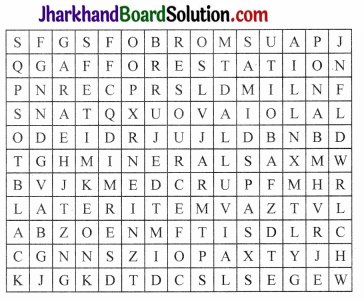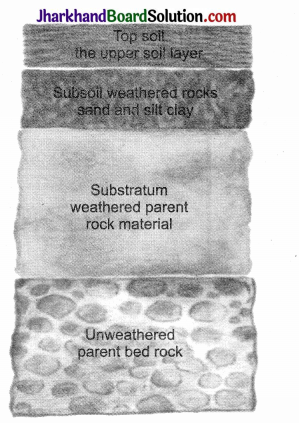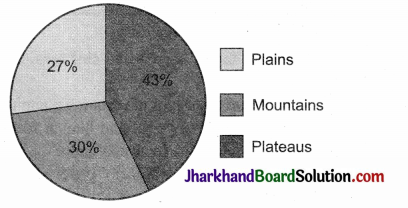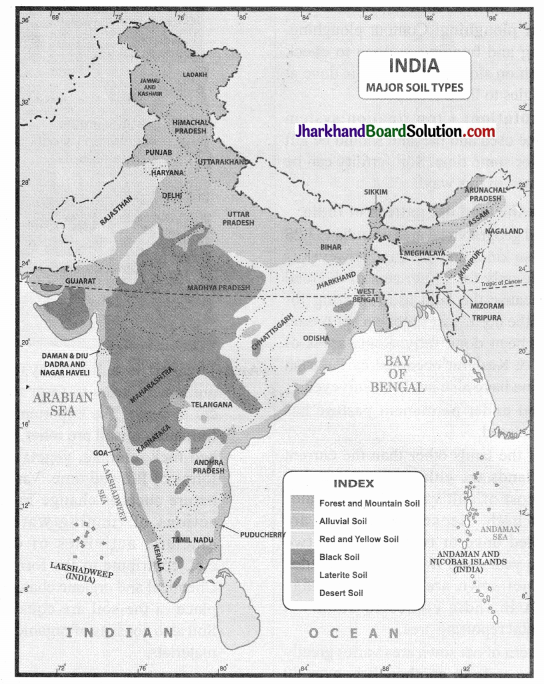JAC Board Class 10th Social Science Solutions Geography Chapter 1 Resource and Development
JAC Class 10th Geography Resource and Development InText Questions and Answers
Page 1
Question 1.
Can you identify and name the various items used in making life comfortable in our villages and towns. List the items and name the material used in their making.
Answer:
| Location | Item | Material used in making them |
| Villages | Proper houses Bicycles and motorcycles Kerosene stoves and LPG Bulbs and tube lights | Bricks, cement, wood, glass, other building materials Steel, rubber, etc. Steel, brass, etc. Copper, tungsten, glass, etc. |
| Towns | Cooking gas stove and cylinder Cars and motorcycles Fans, room coolers and air conditioners Refrigerators and TV sets | Steel, brass, rubber, etc. Steel, plastic, brass, etc. Steel, copper, plastics, etc. Steel, copper, plastics, glass, etc. |
Page 2
Question 2.
Identify at least two resources from each category.
Answer:
Types of resources based on origin
- Biotic Resources: Animals and human beings
- Abiotic Resources: Metals and rocks
- Renewable Resources: Solar and wind energy.
- Non-Renewable Resources: Coal and petroleum
- Individual Resources: Plots and houses
- Community Resources: Playing grounds and public parks
- National Resources: Forests and wildlife
- International Resources: Ocean and sky (beyond certain limits)
![]()
Question 3.
Prepare a list of stock and reserve resources that you are familiar with from your local area.
Answer:
Try to find out information about different resources as you can. Below, there is an example of how you can write about one or two of them.
Stock
- Water in isolated form. We do not have adequate technology to make it fit for drinking.
- There is oxygen in my area because many trees are present here, so due to lack of technology we can’t take oxygen gas and hydrogen gas to form a water molecule.
Reserve
- There is a dam few kilometres away from my town which has reserved water for future generations.
- There are some granaries which has reserved foodgrains for future generations.
Question 4.
Imagine, if the oil supply gets exhausted one day, how would this affect our life style.
Answer:
Do it yourself. Sample answer is given. Transport plays a major role in the society, i. e., it is helpful for transporting of goods or grains from one place to another. So this will also affect their modem lifestyle. It would be harder for the people to generate electricity. Oil is needed to produce electricity through generators.
Question 5.
Plan a survey in your colony/village to investigate people’s attitude towards recycling of the domestic/agricultural wastes. Ask questions about:
(a) What do they think about resources they use?
(b) What is their opinion abQuestion ut the wastes, and its utilisation?
(c) Collage your results.
Answer:
Do it yourself.
Page 4
Question 6.
Prepare a list of resources found in your state and also identify the resources that are important but deficit in your state.
Answer:
Do it yddrself activity. Sample answer is given. A number of minerals are found in our state. Some of them are Potassium, Calcium, Sodium, Coal, Petroleum, Iron ore, etc. But all these are not available in abundant quantity. We have a deficit of coal and bauxite.
Question 7.
What resources are being developed in your surroundings by the community/village panchayats/ward level communities with the help of community participation?
Answer:
Biomass energy, bio-gas, water (by digging well), solar energy (by setting up solar panels), etc., are developed in our surroundings by the community village . panchayats/ward level communities with community participation.
![]()
Question 8.
Find out reasons for the low proportion of net sown area in these states.
Answer:
Net sown area in Arunachal Pradesh, Mizoram and Manipur is low mainly due to the hilly and rocky terrain. They are also largely covered with dense forests, which will need to be cut to develop agriculture. Andaman and Nicobar Islands are covered with dense tropical forests and so net sown area is low.
Question 9.
Try to do a comparison between the two pie charts given for land use and find out why the net sown area and the land under forests have changed from 1960¬61 to 2014-15 very marginally.

Answer:
- Change in net sown area:In 2014-15, net sown area was = 45.5%
- In 1960-61, net sown area was = 46.26%
- Change in this year = 46.26%-45.5% = .76%
- Change in land under forest = 23.3%-18.11% = 5.19%
JAC Class 10th Geography Resource and Development Textbook Questions and Answers
Question 1.
Choose the right answer from the four alternatives given below.
(i) Which one of the following type of resource ¡s iron ore?
(a) Renewable
(b) Biotic
(c) Flow
(d) Non-renewable
Answer:
(d) Non-renewable
(ii) Under which of the following type of resourçe can tidal energy be put?
(a) Rplenishab1e
(b) Human-made
(c) Abiotic
(d) Non-recyclable
Answer:
(a) Rplenishab1e
(iii) Which one of the following is the main cause of land degradation in Punjab?
(a) Intensive cultivation
(b) Deforestation
(c) Over irrigation
(d) Overgrazing
Answer:
(c) Over irrigation
(iv) In which one of the following states is terrace cultivation practised?
(a) Punjab
(b) Plains of Uttar Pradesh
(c) Haryana
(d) Uttarakhand
Answer:
(d) Uttarakhand
(v) In which of the following states black soil is predominantly found?
(a) Jammu and Kashmir
(b) Maharashtra
(c) Rajasthan
(d) Jharkhand
Answer:
(b) Maharashtra
Question 2.
Answer the following questions in about 30 words:
(a) Name three states having black soil and the crop which is mainly grown in it.
(b) What type of soil is found in the river deltas of the eastern coast? Give three main features of this type of soil.
(c) What steps can be taken to control soil erosion in the hilly areas?
(d) What are the biotic and abiotic resources? Give some examples.
Answer:
(a) States having black soil are Gujarat, Maharashtra and Madhya Pradesh. This type of soil is typical of the Deccan trap (Basalt) region spread over northwest Deccan plateau and is made up of lava flows. Black soil is ideal for growing cotton and is also known as black cotton soil.
![]()
(b) Alluvial soil is found in the entire northern plains and river deltas of the eastern coast. Three main features of alluvial soil are:
- Alluvial soil consists of proportions of sand, silt and clay.
- Alluvial soil as a whole is very fertile. This soil contains adequate proportion of potash, phosphoric acid and lime which are ideal for the growth of sugarcane, paddy, wheat and other cereal and pulse crops.
- Soils in the drier areas are more alkaline and can be productive after proper treatment and irrigation.
(c) To stop soil erosion in the hilly areas following steps can be taken:
(i) Afforestation- planting of trees on slopes.
(ii) Ploughing along the contour lines can decelerate the flow of water down the slopes. This is called contour ploughing.
(iii) Steps can be cut out on the slopes making terraces. Terrace cultivation restricts erosion.
(iv) Large fields can be divided into strips. Strips of grass are left to grow between the crops. This breaks up the force of the wind. This method is known as strip cropping. birds, marine life and human beings are some of the examples of biotic resources. Abiotic Resources: Resources which are composed of non-living things are abiotic resources. Land, water, soil and minerals are some of the examples of abiotic resources.
Question 3.
Answer the following questions in about 120 words:
(a) Explain land use pattern in India and why has the land under forest not increased much since 1960-61?
(b) How have technical and economic development led to more consumption of resources?
Answer:
(a) In India, land resources are primarily divided into agricultural land, forest land, land for pasture and grazing and waste land. According to the data, about 54% of the total land area is cultivable or fallow, 23.3% is covered by forests, and 3.3% is used for grazing. The rest is waste land.
The land under forest has not increased since 1960-61 because:
- After independence demand for more land to expand agriculture, mainly after Green Revolution.
- Developmental works and infrastructural facilities led to clearance of forests areas.
- Industrialization and urbanization also decreased the forest area.
(b) (i) Technical and economic development involves more utilization and exploitation of resources for the purpose of present development.
(ii) The history of colonization reveals that it was the higher level of technological development of the colonizing countries that helped them to exploit resources of other regions and establish their supremacy over the colonies
(iii) According to Gandhiji, the greedy and selfish individuals and exploitative nature of modem technology are the root cause for resource depletion at global level.
(iv) Economic development takes place through proper utilization of available resources for the purpose of advancement of present generation.
(v) With economic development the capacity of accessing or consuming of resources by the people increases and technical development makes further resources available at their disposal.
(vi) Technical development makes resources accessible and usable. It aids in further exploitation as well as creation of new resources.
NCERT ‘Project’ Activity
Question 1.
Make a project showing consumption and conservation of resources in your locality.
Answer:
Make aproject/chart with these guidelines.
| Resources | How we consume |
| Agricultural Resources | For food, clothing, etc. |
| Water Resources | For drinking,-washing, irrigation, etc. |
| Industrial Resources | Such as kitchenware, washing machine, electronic goods, etc. |
Question 2.
Have a discussion in the class: how to conserve various resources used in your school.
Answer:
Do it yourself.
Question 3.
Imagine if oil supplies get exhausted, how will this affect our life style?
Answer:
If oil supplies get exhausted, it will adversely affect our life style.
- Without oil, it will be difficult to run industries.
- Transportation facilities will be affected
- Agricultural production will suffer and come to a standstill.
![]()
Question 4.
Solve the puzzle by following your search horizontally and vertically to find the hidden answers:
- Natural endowments in the form of land, water, vegetation and minerals.
- A type of non-renewable resource.
- Soil with high water retaining capacity.
- Intensively leached soils of the monsoon climate.
- Plantation of trees on a large scale to check soil erosion.
- The Great Plains of India are made up of these soils.

Answer:
- Resource
- Minerals
- Black
- Laterite
- Afforestation
- Alluvial



